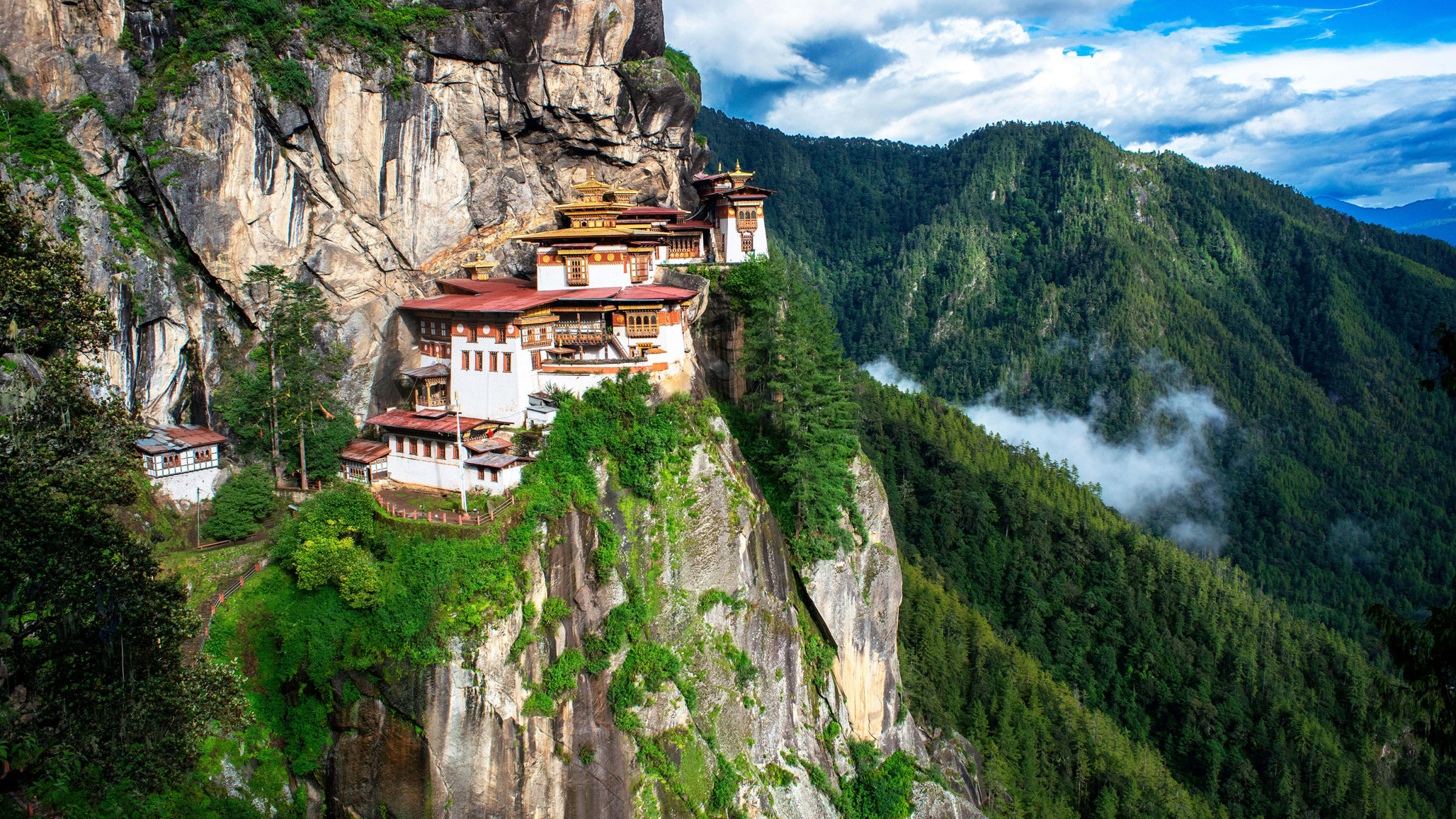10 Best Places to Visit in Bhutan

Introduction
Bhutan, a tiny landlocked nation high in the Himalayas, is one of the world’s most minor popular travel destinations, which suits its particular brand of tourism. With a focus on environmental tourism, the nation restricts the number of visitors it receives at any given time by making entry very difficult and requiring all travelers to book a tour through one of the thousands of approved and accredited travel agencies.
Bhutan’s western and central regions, particularly in and around Paro, Thimphu, and Punakha, are home to most of the country’s top attractions. Famous Buddhist sites, breathtaking Himalayan treks, and Bhutan’s cultural center can all be found there. Here is the list of the top ten places to visit in Bhutan for any tour of the final great Himalayan kingdom if you are planning one soon.
The Following are Top 10 places to visit in Bhutan:
- Thimphu
Thimphu, Bhutan’s capital and largest city, is located in one of the country’s most beautiful valleys in the western part of the country’s central region. Given capital status in 1961, Thimphu replaced Punakha, the former historic capital of the kingdom and the residence of Bhutan’s religious authorities before the coronation of its royal family. The Wang Chhu River’s banks are where the sprawling city is located. The Tashichho Dzong, an ancient fortress monastery at the edge of the town that once served as the seat of government for the civil leaders of Bhutan, is just one of the fantastic and astounding sights to see in the city, even though it does not have a spectacular nightlife for younger generations of tourists.
- Buddha Dordenma Statue
The Buddha Dordenma Statue, one of the largest Buddha rupas in the world, stands 52 meters tall and contains more than 125,000 tiny statues of the Buddha. It was built in the mountains to commemorate the 60th anniversary of the fourth Bhutanese king, Jigme Singye Wangchuck. The project, which was made to resemble Sakyamuni Buddha’s sitting statue, cost over $100 million US to complete. The Kuensel Phodrang Nature Park, which covered 943 acres of forested land and was established in 2011, is located close to the Buddha statue and offers visitors to the area a tranquil place to unwind. It’s interesting to note that Padmasambhava predicted the figure’s construction in an old term from the eighth century, which was repeated by the yogi Sonam Zangpo in the early twentieth century.
- Paro
The second city of Bhutan, located in the lovely Paro Valley, is the first place you will see when you arrive in the nation because it is home to its only international airport. The location, alongside the Paro River, has housed monasteries of various kinds since the 10th century and served as Bhutan’s northern stronghold against invasion from Tibet. Rich and intricate architecture can be found along the city’s main street, where cafes and restaurants compete for space with traditional Bhutanese houses and shops. As well as many prayer-related artifacts, Paro is a great place to find one-of-a-kind antiques and Buddhist trinkets. However, antiques cannot be exported from the kingdom.
- Taktsang Monastery
The magnificent Taktsang or “Tiger’s Nest” monastery is perched on a ledge halfway up the mountain’s cliff face, more than 800 meters above the Paro Valley. The Taktsang Monastery, renowned throughout the world for its singular and breathtaking location, has earned legendary status in Bhutan and throughout many Asian countries as well as other regions where Buddhism is practiced. Legend has it that the Guru Rinpoche (Padmasambhava), who is credited with introducing Buddhism to Bhutan, meditated on this mountain after flying there on the back of Yeshe Tsogyal, a mythical giant tigress. He emerged in eight manifestations, and the location was made holy after spending three years, three months, three weeks, three days, and three hours in meditation in the 13 caves on the ledge. A cultural landmark of the Bhutanese people, the monastery was constructed around the caves in 1692.
- Rinpung Dzong
One of Bhutan’s most well-known temples, Rinpung Dzong, is a sizable monastery and fortress that belongs to the Kagyu school of Buddhism. It also serves as the regional Monastic Body of Governance. The site of the Dzong, which was given to the Buddhist Lamas in the 15th century, where a small temple was constructed, is one of Bhutan’s “tentative” sites on the UNESCO inclusion lists for future World Heritage Sites. The Zhabdrung Rinpoche received the temple in the 17th century, demolished the earlier building, and erected the Dzong that is still there today. In 1646, it was rededicated and turned into western Bhutan’s administrative and monastic hub. The Dzong was featured in the 1993 film Little Buddha.
- Chele La Pass
Chele La Pass, at about 3,989 meters above sea level, is thought to be the highest pass in Bhutan that is reachable by car. It is one of the most well-liked high points to visit in Bhutan. The key provides some breathtaking views of the waterfalls, forests, and alpine valleys nearby as it rises above the pristine forests of the Haa Valley in the Paro District. The drive to the pass takes just over two hours and takes you past rivers, waterfalls, and dense forests while providing breathtaking scenery. The locals have erected hundreds of prayer flag-adorned poles alongside the road leading up to the pass to frighten away demons and evil spirits.
- Punakha Dzong
Punakha Dzong, the second-oldest Buddhist Dzong in the country, is a 17th-century monastery built by the first Bhutanese Zhabdrung Rinpoche and is also known as Pungtang Dewa chhenbi Phodrang, which translates to “the palace of happiness and bliss.” The Dzong, which served as Bhutan’s administrative center until 1955, is home to some of the most revered Buddhist artifacts from the Drukpa Lineage of the Kagyu School and the mortal remains of the first Zhabdrung Rinpoche. The marriage of King Jigme Khesar Namgyel Wangchuck and his bride, Jetsun Pema, in October 2011 took place at the Dzong and was broadcast live on national television for the first time in Bhutan.
- Phobjikha Valley
Phobjikha Valley also referred to as the Gangteng Valley, is a sizable U-shaped glacial valley in central Bhutan and the location of the well-known Gangteng Monastery. The valley is famous for the rare black-necked cranes that migrate there from their summer habitat in Tibet for the winter. The cranes arrive in the final week of October, fly three times around the roof of the Gangteng Monastery, and then land in the valley’s wetlands. They repeat this unusual maneuver when they depart for Tibet once more in March. Buddhists interpret the cranes’ mysterious behavior as a lucky sign or good omen, and the entire valley where they spend the winter is protected. The valley is home to more than ten other protected species of birds and animals, in addition to being the best marshland in all of Bhutan. Hundreds of birdwatchers visit the region in October and March to see the incredible spectacle of the cranes, and the three-day trek through the valley is well-known.
- Chomolhari
This enormous mountain, also known as Jhomolhari, is 7,326 meters tall, but there are more tall mountains in Bhutan. The mountain, which straddles the border between Tibet and Bhutan, is the source of the Paro and Amo rivers flowing down its southern and northern sides, respectively. Bhutanese Buddhists consider it the residence of one of the Five Tsheringma Sisters, the female protector goddesses of Tibet and Bhutan who Padmasambhava constrained to guard the people, the lands, and the Buddhist faith from evil demons. This mountain is known as the “bride of Kanchenjunga” and is considered the home of the Five Tsheringma Sisters. One of Bhutan’s highest lakes, the Tseringma Lhatso, or “spirit lake,” is just one hour’s walk up the mountain from the Chomolhari Temple, located on the south side of the mountain at 4,150 meters.
- Jigme Dorji National Park
The Jigme Dorji National Park, a picturesque area of unspoiled wilderness, was created in 1974 to protect the indigenous species of endangered animals in Bhutan, more than 37 of which live in this region, covering more than 4,300 square kilometers. Its elevation ranges from 1,400 meters to over 7,000 meters, and rare mammal species like the Bengal tiger, clouded leopard, snow leopard, Himalayan black bear, Indian leopard, and the well-known Bhutanese Takin call it home. The park, which has a wide variety of native and migratory birds, is also home to numerous species of deer, goral, and sambar. The park provides its visitors with a spiritual experience because it contains countless sites of religious and cultural significance.



